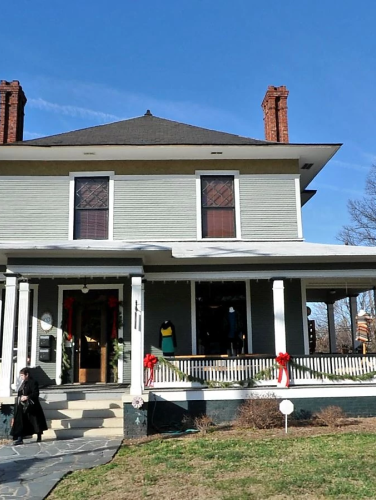
Charles W. Parker House
(ca. 1904)
One of Piedmont Park’s first houses and an early example of the Four Square architectural style.
901 Central Ave., Charlotte, NC 28204
Built in 1904 for one of Charlotte’s leading furniture dealers, the Charles W. Parker House is one of the city’s earliest examples of the Four Square style, an early twentieth-century architectural movement that emphasized more simplistic and sensible designs. As opposed to the more eclectic and ostentatious Queen Anne and Colonial styles, Four Square homes featured more geometric massing and minimal decorative surfaces, incorporating elements of both the Prairie School and Craftsman styles. Considered one of Charlotte’s finest homes when it was completed, the Charles W. Parker House received prominent coverage in the 1905 Art Work of Charlotte, North Carolina volume compiled by Chicago’s Gravure Illustration Company.
Property Quick Links
Parker (1866-1950), a native of New London, North Carolina, moved to Charlotte in 1886 and went to work for the E.M. Andrews Furniture and Music Company on West Trade Street. By 1902, Parker and his brother William, along with James O. Gardner, had bought out the company, renamed it the Parker-Gardner Company, and upgraded the firm’s offerings to include fine furniture, carpets, curtains, pianos, organs, and pianos. Within one year, the Parker-Gardner Company began marketing itself alternatively as “The Largest Dealer in the State” and “The Largest Dealers in the South.” True to its name, the firm counted North Carolina Governor Cameron Morrison among its clientele and even secured a contract to furnish the South Carolina State House in Columbia. Charles Parker and his wife Louise celebrated their prosperity with the 1902 purchase of land in Piedmont Park – one of Charlotte’s then-newest and most elite streetcar suburbs – on which to build this house. Parker’s business partner James Gardner built his family’s home on the same block.
The Depression forced the Parker-Gardner Company to change its business model. Dropping its furniture lines, the firm focused instead on musical instruments, sheet music, and records, with Charles becoming more of a traveling salesman. His family also adapted, taking in boarders at their Central Avenue home, including John Akers, the founder of Akers Motor Lines. Such measures helped the family maintain ownership of the house, where they continued to reside until Charles’ death in 1950 and Louise’s death in 1976 at the age of 105. The house has since served as a halfway house for former patients of mental hospitals and as a retail establishment.

